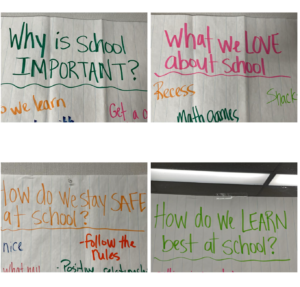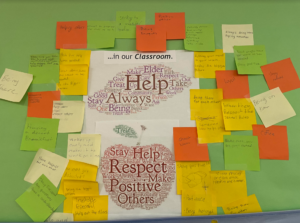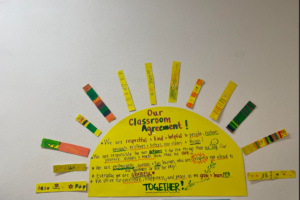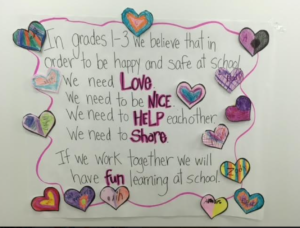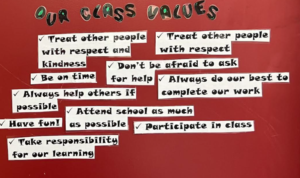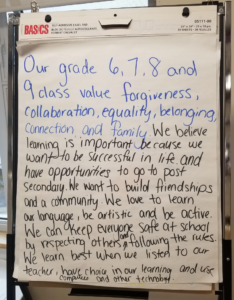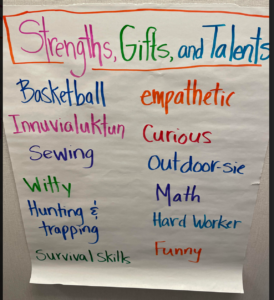Building The Community of Learners: Values and Beliefs
Guiding Understandings:
Place is an integral concept in Indigenous Worldview. Teaching and learning in Indigenous communities is place based. “Place” refers to the land, language, culture, history, and relationships that make life possible. We demonstrate reconciliation when we learn about the place we are teaching in and the history and stories of the people in those communities. The traditional organization of communities and their values are the foundation of how we should approach teaching in order to form our own classroom community of learners.
Traditionally, Indigenous communities in the Beaufort Delta Region were structured to value and lift up the strengths and talents of the people living together. This intuitive knowledge of people was necessary in order to survive the harsh conditions of these lands. Traditional communities were built on values that centered on sharing, respect for all things, (land, people, self, spirit), importance of roles, ways of knowing, being and doing etc; survival was based on the relationality of all things.
The school is a community and survival is its goal – in this case, survival equates to students’ success and the fostering of capable people. In order to achieve survival, we need each other and we need to ensure that Relationality is a core value in our practice.
“Indigenous communities come together to celebrate strength in good times and support one another in times of struggle”. The goal is for teachers to foster an environment that mirrors these values of Indigenous communities.
Big Idea: Shared classroom values and beliefs help all members of the community work to become capable people and form a strong supportive community.
Essential Question:
How do our collective values play an important role in making our community a strong and welcoming place and how do we honour these places in the process? (Place refers to the Indigenous communities we are situated in)
Culminating Task:
- Students will utilize the student-generated answers from the prescribed questions to create a Belief Statement about their learning and school.
- The Belief Statement will be shared with school Admin and student families
Connections to Core Competencies:
- Nurture who I am and who I want to be: This competency relates to identity and ways to grow understanding of the self and set goals to work with others.
- Construct ways of being and living well together: Understanding collective and individual values and beliefs and working together towards common understandings and goals.
Connections to Capable Person:
- Students who are able to think holistically about themselves and the culture they come from.
- Students who learn about the values and beliefs of the Indigenous communities in which they live and make connections between these and what they are learning.
Oracy strategy:
Using the oracy strategy A/B Partner Talk, students will continue to develop these skills using a more complex sentence stem this time. Students are deepening their skills to gather ideas and thoughts on a given topic by actively listening to their partner’s ideas and then giving their partner their own ideas so that they can be shared out to the whole group by each other.
Inquiry Type:
Structured Inquiry: Students will receive explicit step-by-step guidelines at each stage, leading to a predetermined outcome, similar to following a recipe.
Gauging Prior Knowledge and Honoring Student Voice:
The following activities are suggestions only, which may assist you with completing the culminating task. However, Oracy development is a must, so teaching the strategy outlined is necessary in some way. As a classroom teacher, you may choose which activities to complete, which to remove, and where more activities need to be completed. The culminating task is mandatory to complete.
Possible Pathways:
- Teacher facilitated discussion using DK and IQ values as references (see resource sheet). Include a local guest speaker or an Elder to speak about values and beliefs.
- T-chart with individual values column and collective values column
- Family interviews and class share
- Partner talk and small student group collaboration
- Rotating stations for small groups to add to collective values to chart paper
- Art activity for students to reflect on and share personal values
Learning Connections:
- Dene Kede (pages. xxxi, xxxvii, xxxviii)
- Inuuqatigiit (pages. 8-16)
- ELA Outcome 1 & 5
Teacher Reflection:
- What are your values about teaching and learning and education?
- What are some of the things you have learned about the Gwich’in and/ or Inuvialuit people since you have been in the community you are teaching?
- What do the Dene Kede and Innuuqatigiit teach us about the values around teaching and learning for Indigenous communities? (The first 25-30 pages of each document discuss these).
- Check out this Teaching and Learning Practices document and reflect on ways you can bring these practices into your teaching.
Activities
Activity 1: Learning to communicate in the classroom community
Students are working on their competency of communicating and living well together. They will continue to practice using structured partner talk in this activity.
Strategy: A/B partner talk with a given script
How To:
- Partner students into 2s choosing which will be Partner A and Which will be Partner B
- Student pairs are given a short script
- Students share ideas with one another in order to answer the question that is in the script
- When it is time to share, The teacher chooses partner A or B to share first and then in the next round the other partner shares.
- A shares for B and B shares for A
Topic: Things that are important to us:
- My partner ______________________________thinks that ________________________________________ is very important because _________________________________________________________________.
- My partner ______________________________ thinks ___________________________________________ is very important because _________________________________________________________________.
Extensions:
- In addition to those things, I believe that ______________________________________ helps us (at home, at school)
- Also, because ______________________________ is important to me, I make sure I ___________________________________________________________________________________________.
Resource Sheet and Activity: Beliefs & Values
Beliefs are the convictions that we generally hold to be true – usually without actual proof or evidence. Beliefs are usually based on cultural or personal experiences and grow from what we see, hear, experience, read and think about.
From our beliefs, we derive our values. Our values are things that we deem important and can include concepts like equality, honesty, education, effort, perseverance, loyalty, faithfulness, etc…Values motivate our actions and help us make decisions.
Suggestions on how to generate student ideas and discussion with the questions below: start with a few rounds of content circles for these questions to generate whole group ideas and then have students help create a mindmap/ brainstorm list from what was shared so that all can access, next, have students break into small collaborative groups and discuss thoughts and ideas to the remaining questions. You can use a placemat, chart paper etc. Finally have students share out to the main group and you can add thinking to the class brainstorm.
Questions to help students investigate their own beliefs and values:
- What makes you happy? What makes you sad? What makes you mad?
- What do you really care about?
- What traditions does your family have? What traditions does your community have?
- What would you like to change in the world? What do you love about the world?
- What characteristics do you like about yourself? About other people?
| Example | Individual | Collective |
Beliefs |
|
|
Values |
|
|
Dene Kede & Gwich’in Governance
Beliefs: “The creation story tells us that because we were created last of all beings, our continued survival requires us to be in respectful relationship with the land and all of its animals, the spiritual world, other people and ourselves.” (Dene Kede, Pg. XV) Gwich’in Tribal Council Website with Values and beliefs
Values:
Inuuqatigiit & Inuviaulit Governance
Beliefs:
“Inuit have strong ties with their family through elders and kinship. The unity of a family or group is important to the community structure. Children are raised not only by their immediate family, but by extended family and the community. Children are told at a very young age to listen, to honour and obey their parents, elders and other adults. This, they believe, will give you a long and meaningful life.” (Inuuqatigiit, Pg. 9)
Inuvialuit Regional Corporation Website with information on Culture and beliefs
Values:
“Inuit value life: being welcoming, smiling, respectful, sensitive, enjoying humour, giving, honest, patient, accepting and overcoming grief are some of the strengths valued by Inuit. Elders tell us to be good to others; that one must treat others equally, with kindness, and smiles, regardless of their age or who they are. Elders also say that one must not give up on life regardless of obstacles and tragedies.” (Inuuqatigiit, Pg. 9)
Suggested Extension:
- Connect with an Elder or community resource person outside of the school and ask them to come in and talk to the students about values and beliefs of their community.
- Here is a small slide show that help students access values and beliefs. (Geared for Grade 4-6)
- Here is a small slide show that help students access values and beliefs. (Geared for Grade 7-9)
Examples of connecting Values and Beliefs to the Indigenous communities:
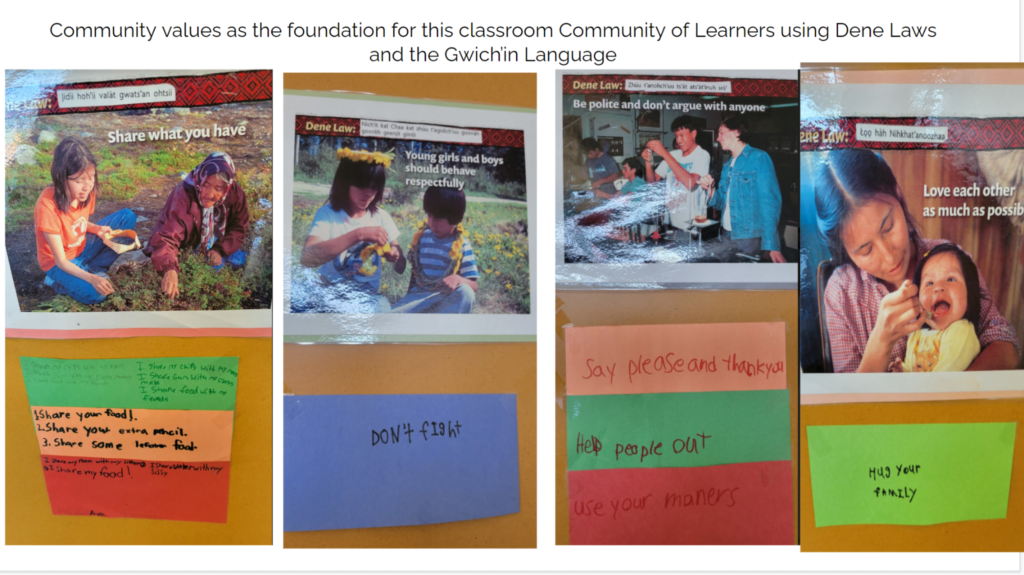

Lorem ipsum dolor sit amet, consectetur adipiscing elit. Ut elit tellus, luctus nec ullamcorper mattis, pulvinar dapibus leo.
Land and Community Connection
Activity 2: Introduction to Sit Spots
“Learning needs to connect to and support the land. The relationship to land and place is deeply rooted in Indigenous cultural perspectives, living and learning are intricately connected to sense of place and to the land itself” (chrona, 2022 p. 123). The meaning of connection is manifold: all living things are in a relationship with the land, emotional and physical wellbeing is tied to the land, land is a nourisher and connects to the collective spirit. As educators in Indigenous communities we need to be able to live, learn, work and play in connection to the land and place we are in. A Sit Spot practice is a way to connect learners to the land.
Setting up Sit Spot routines in your practice:
- Find a location for your sit spot activity outside, preferably in an open or wooded area – it can be near the school grounds.
- Set an intention and time frame
- Be explicit about the importance of connecting to land. (You can learn more about the importance of connecting to the land in learning by reaching out to a local Elder or community member, ask your ILI or SA, and read the Dene Kede and Innuqatigiit.
- Make protocols, expectations, and routine explicit to students
Reflections for students in their Sit Spots:
- Listen. What do you hear? Can you identify the sounds?
- Watch for movement. What do you see? Can you see tiny bugs, or birds, or squirrels?
- Look. What is your view? Is there anything new in your sit spot today, like a fallen leaf or a bird feather?
- Reflect and wonder. What questions do you have? What thoughts seemed to linger?
Key Points:
- Sit spots are an impactful way to connect to the land and foster land based regulation.
- Try to choose a spot that is accessible, safe, and allows for students and staff to spread out and find a quiet separate space to connect with the land.
- Sit spotting is a gradual build and the length, focus and intentionality of the activity expands and develops over time and consistent practice.
- The goal for this particular Sit Spot is to connect to the land and reflect on why it is important and what does it teach us.
- This is an activating task or a provocation for the thinking about values and beliefs contained in this component.
Activity 3: Partner Talk to help students think about Values and Beliefs
Give student pairs an opportunity to talk about these things:
- What is important to them at school?
- Why do they like coming to school?
- What do they believe is important for a safe and welcoming classroom?
Partner Scripts:
Partner A:
My partner thinks ________________________________________ is important about school and they like coming to school because __________________________________________________________________________________________
Finally, they think that ____________________________________________________________________ is important for a safe and welcoming classroom.
Partner B:
My partner thinks ________________________________________ is important about school and they like coming to school because ____________________________________________________________.
Finally, they think that ________________________________________________________________is important for a safe and welcoming classroom.
Activity 4: Big Idea: Gauging Students Background Knowledge
Task:
As a whole group, pose a series of questions on the discussion board (digital/physical) for your students to engage in conversation about their beliefs about school (i.e. What do students like about school? How do they feel about school? What would they like to help them learn best? Why is school important?). These ideas should be utilized as questions for Activity 4.
Participants:
For this activity, the classroom teacher is responsible for guiding the students to think about the positive aspects of school and community that they like best. This information will be utilized to develop our Belief Statement (culminating Task). It is important to invite both community and school leaders to participate in activities. Think about inviting:
- Principal
- Program Support Teacher
- Instructional Coach
- Leveled Literacy Intervention
- Support Assistant
- Community Organizations
- Elders
Outcomes:
*** Include all student thinking by encouraging post it drawings, collaboration and peer support strategies, helping to record and capture thinking etc***
All students will have the opportunity to share in a guided conversation with the classroom teacher utilizing their communication and thinking skills to generate meaningful values and beliefs. Students may come up with ideas such as:
- School should be a fun and productive place
- School should be safe
- We should learn at school
Task:
Using the ideas about school generated in Activity 4, turn them into questions – each will be a heading on a chart paper. In small groups, have students generate ideas about each of the headings you have created. Provide time for students to contribute ideas in any way they wish.
Activity 5: Big Idea: Building Collaboration & Community
Further Information:
1. Collate the chart papers from the previous activity together for students to use as the content to create a shared write of your classroom belief statement.
2. You will want to identify and prioritize items from each sheet in order for students to draw out what is most important.
- With your students, select important ideas by underlining or circling
- Mark repeat choices to help students rank/prioritize ideas
- Create a list on the board or a new sheet of chart paper that shows the chosen/ prioritized ideas
Outcomes:
- All students will have the opportunity to contribute to providing their voice and to choose to work independently or with their peers promoting choice and agency.
- All students will have the opportunity to highlight their important ideas.
Activity 6: Culminating Task
The Community of Learners Belief Statement
Task: As a whole class group, the classroom teacher will facilitate a shared write where you and your students create a belief statement. When this is done you will display it on the wall in an area where it can be viewed and revisited often.
Ideas for scaffolding skills:
- Mini lesson opportunity for sharing ideas in writing
- Model the process between generating ideas and writing
- Model including all voices
- Make moves to include all learners through oral contributions, visual representations, and low risk entrance questions. Give choices that invite all learners into the work.
Further Information:
This statement reflects the knowledge, needs, and understandings of your community of learners at this point in time. As your community learns and grows you will be able to add new learning from reflection and make sure that it reflects the most current and up to date content for your classroom.
Check in with the Outcomes:
- You have produced a Belief Statement that reflects the knowledge and understanding of your classroom community of learners (all perspectives are present: the students, the teacher, and SAs).
- This statement is accessible and in a language that students can understand and use with each other to support and assist fellow classmates in challenging times.
- Belief Statement is shared with administration and shared out in communication with family members
Reflection:
As a group, discuss the ways in which you will use this belief statement to help ALL members of your classroom community succeed.
Examples

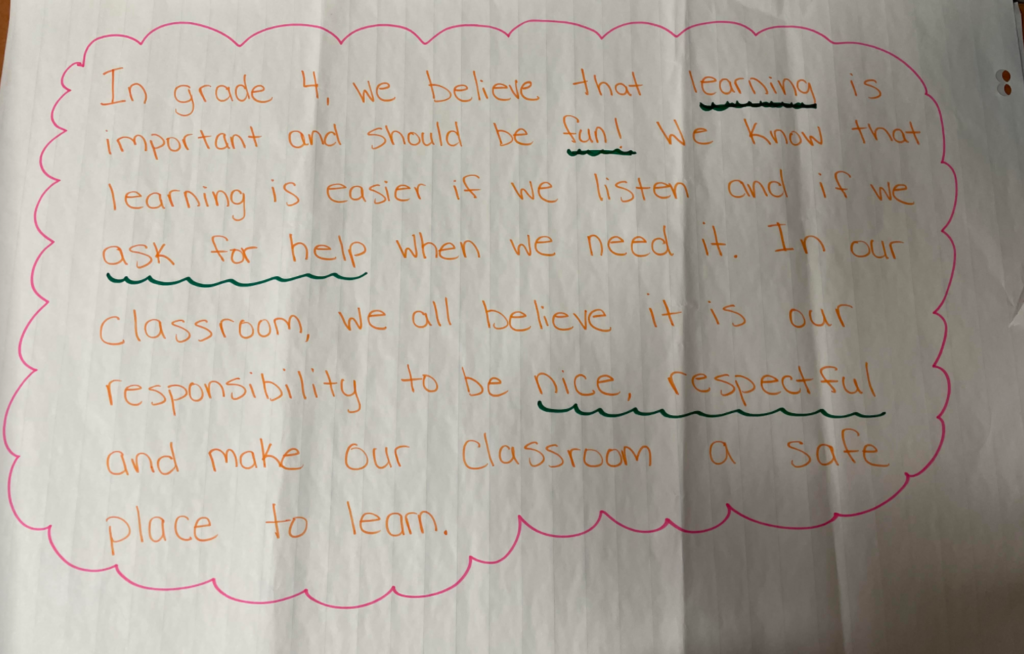
Though different in scope, these 2 examples were generated from the same content which came out of the chart paper belief exercise.
Other Examples
Extension:
Now that you have your values and Belief statement finished and ready to display on the wall– it’s time to add the strengths of your learners to the statement in order to make it visual for the members of the classroom community how their strengths can add to success in carrying out what is valued and believed for success at school.
Take the strength, gifts, and talents anchor chart that you made during the “Collective Strengths” section of the CCL and arrange the strengths around the values and beliefs statement your classroom community helped create.


